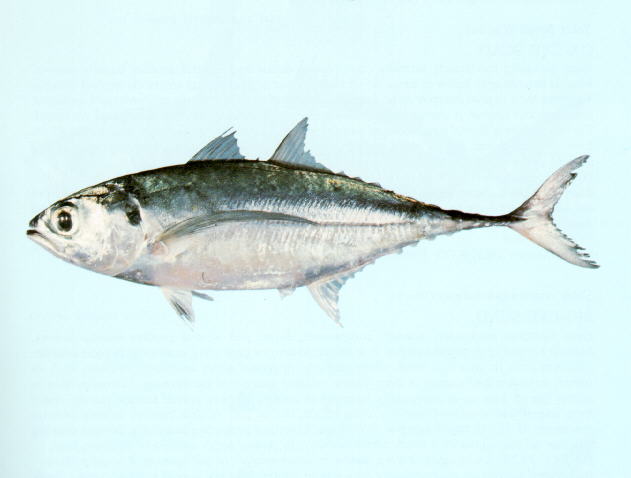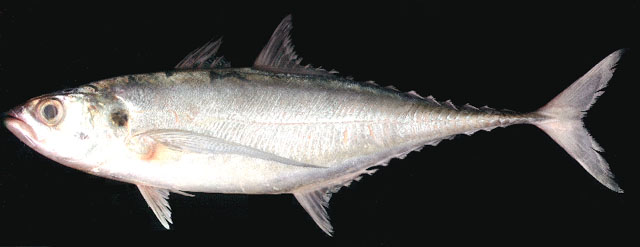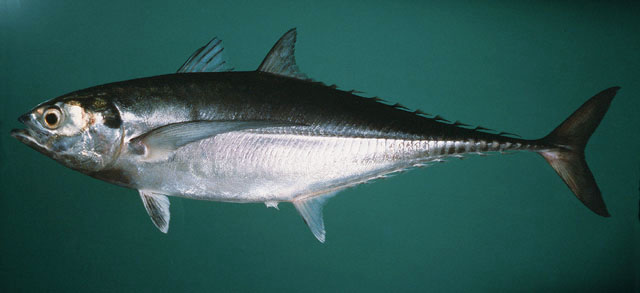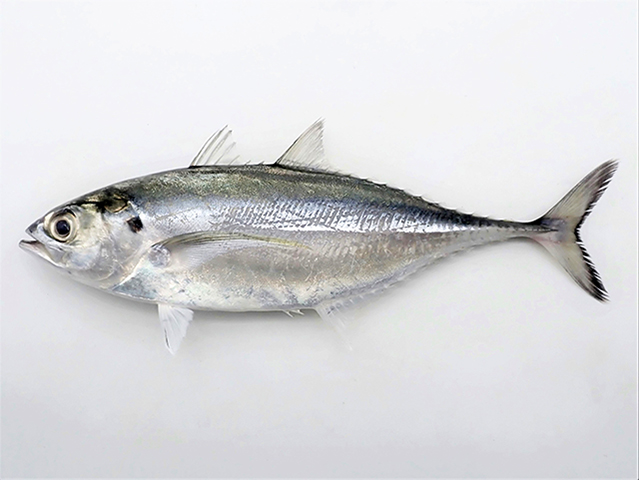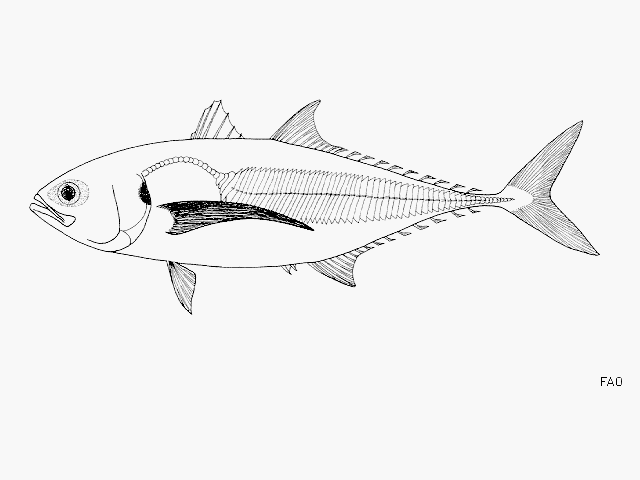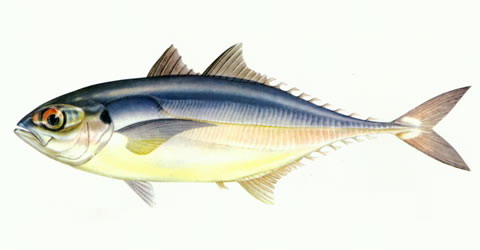Megalaspis
cordyla
(Linnaeus,
1758)
Torpedo scad
View all media / Upload your photos and videos
Expand all
Classification / Names
Teleostei (teleosts) > Carangiformes (Jacks) >
Carangidae (Jacks and pompanos)
> Caranginae
Etymology: Megalaspis: Greek, megas, megalos = great + Greek, aspis,-idos = shield (Ref. 45335).
More on author:
Linnaeus.
Environment / milieu / depth range / climate zone / distribution range
Distribution
Indo-West Pacific: East Africa to Japan and Australia.
Maps

Megalaspis cordyla / Native range
AquaMaps Data sources:
GBIF
OBIS
This map was computer-generated and has not yet been reviewed.

Megalaspis cordyla / Suitable habitat
AquaMaps Data sources:
GBIF
OBIS
This map was computer-generated and has not yet been reviewed.

Megalaspis cordyla / Point map
AquaMaps Data sources:
GBIF
OBIS
This map was computer-generated and has not yet been reviewed.

Megalaspis cordyla / Year 2050
AquaMaps Data sources:
GBIF
OBIS
This map was computer-generated and has not yet been reviewed.
Length at first maturity / Size / Weight / Age
Short description
Dorsal spines (total): 9; Dorsal soft rays (total): 18 - 20; Anal spines: 3; Anal soft rays: 16 - 17. Description: Bluish grey to green dorsally; shading to silvery on side and belly; dark fins. Opercle with large black spot on upper rear edge (Ref. 2334). Body elongate and subcylindrical, slightly compressed; caudal peduncle strongly compressed with distinct median keel; breast scaleless ventrally (Ref. 90102). LL scutes 51-59, strong and very large. Anal fin with 2 detached spines (Ref. 2334). Numerous dorsal and anal finlets are distinct (Ref. 37816). Adipose eyelid completely covering eye except for vertical slit at middle of pupil (Ref. 90102).
Biology
Main reference
Paxton, J.R., D.F. Hoese, G.R. Allen and J.E. Hanley 1989 Pisces. Petromyzontidae to Carangidae. Zoological Catalogue of Australia, Vol. 7. Australian Government Publishing Service, Canberra, 665 p. (Ref. 7300)
IUCN Red List Status (Ref. 125652)
Least Concern (LC); date assessed: March 09 2015
CITES (Ref. 123416)
Not Evaluated
CMS (Ref. 116361)
Not Evaluated
Threat to humans
Harmless
More information
- Countries
- FAO areas
- Ecosystems
- Occurrences
- Introductions
- Stocks
- Ecology
- Diet
- Food items
- Food consumption
- Ration
- Common names
- Synonyms
- Metabolism
- Predators
- Ecotoxicology
- Reproduction
- Maturity
- Spawning
- Spawning aggregation
- Fecundity
- Eggs
- Egg development
- Age/Size
- Growth
- Length-weight
- Length-length
- Length-frequencies
- Morphometrics
- Morphology
- Larvae
- Larval dynamics
- Recruitment
- Abundance
- References
- Aquaculture
- Aquaculture profile
- Strains
- Genetics
- Allele frequencies
- Heritability
- Diseases
- Processing
- Mass conversion
- Vision
- Pictures
- Stamps, Coins Misc.
- Sounds
- Ciguatera
- Speed
- Swim. type
- Gill area
- Otoliths
- Brains
Estimates based on models
Preferred temperature (Ref. 123201): 23.5 - 28.6, mean 27.5 °C (based on 707 cells).
Phylogenetic diversity index (Ref. 82804): PD50 = 1 [Uniqueness, from 0.5 = low to 2.0 = high].
Bayesian length-weight: a=0.01288 (0.01159 - 0.01432), b=2.93 (2.90 - 2.96), in cm total length, based on LWR estimates for this species (Ref. 93245).
Trophic level (Ref. 69278): 3.9 ±0.6 se; Based on food items.
Resilience (Ref. 120179): Medium, minimum population doubling time 1.4 - 4.4 years (K=0.13(?)-0.35; Fec=146,400).
Prior r = 0.57, 95% CL = 0.37 - 0.85, Based on 20 data-limited stock assessments.
Fishing vulnerability (Ref. 59153): Low to moderate vulnerability (29 of 100).
Climate vulnerability (Ref. 125649): Very high vulnerability (86 of 100).
Price category (Ref. 80766): High; Reliable: based on ex-vessel price for this species.
Nutrients (Ref. 124155): Calcium = 140 [25, 418] mg/100g; Iron = 1.59 [0.48, 3.65] mg/100g; Protein = 20.8 [19.1, 22.3] %; Omega3 = 0.198 [0.093, 0.452] g/100g; Selenium = 69.4 [22.3, 176.7] μg/100g; VitaminA = 23.1 [5.0, 132.0] μg/100g; Zinc = 0.544 [0.132, 1.912] mg/100g (wet weight); based on nutrient studies.

